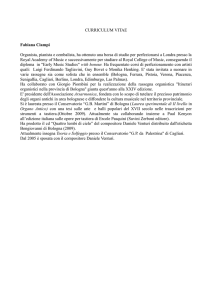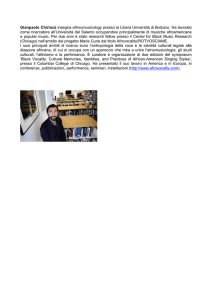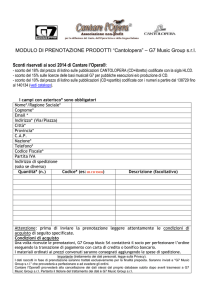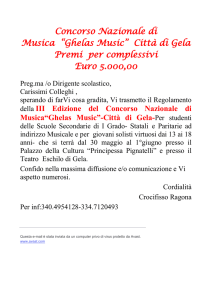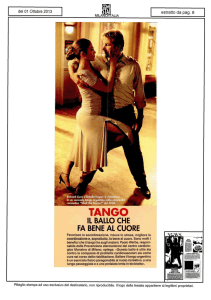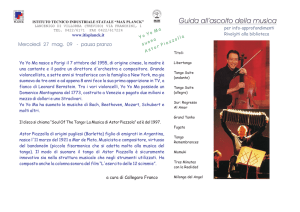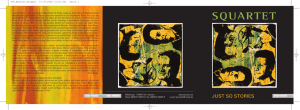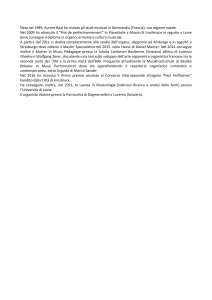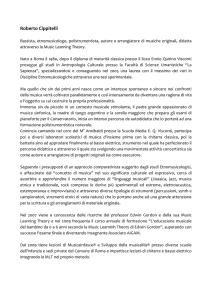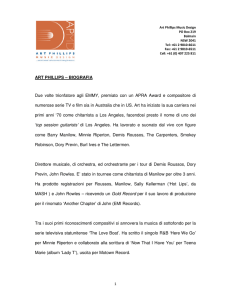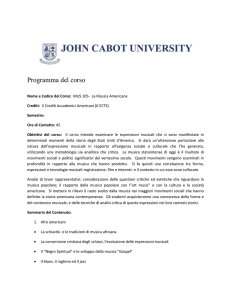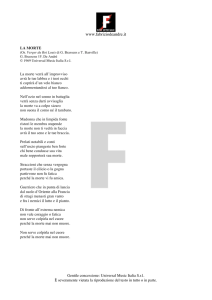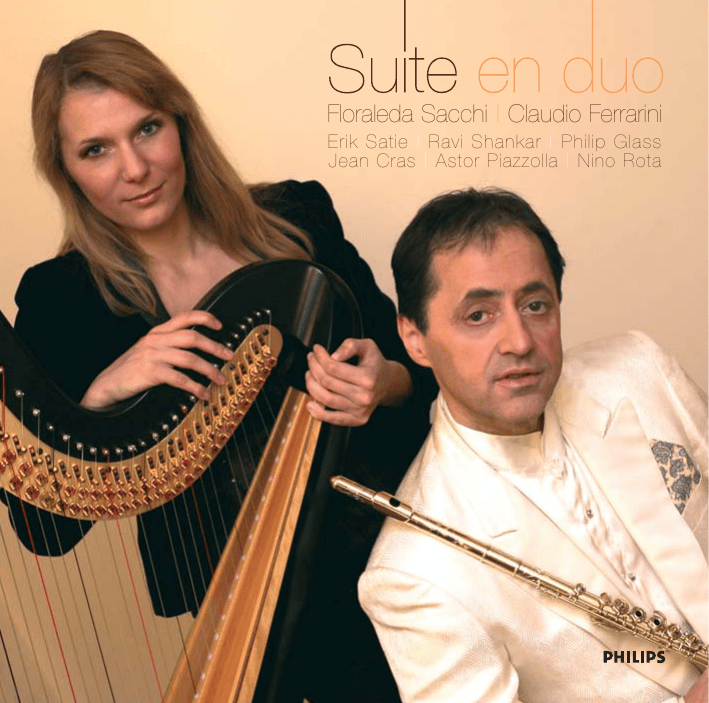
Floraleda Sacchi | Claudio Ferrarini
Erik Satie | Ravi Shankar | Philip Glass
Jean Cras | Astor Piazzolla | Nino Rota
Floraleda Sacchi | arpa
Claudio Ferrarini | flauto
1 ERIK SATIE (1866-1925)
Gymnopédie n.1 Lent et douloureux
3.26
2 PHILIP GLASS (1937) Open the Kingdom*
6.27
3
4
5
6
7
8
9
10
ASTOR PIAZZOLLA (1921-1992)
Histoire du Tango
Bordel 1900
Café 1930
Nightclub 1960
Concert d’aujourd’hui
3.59
7.53
6.49
3.13
JEAN CRAS (1979-1932) Suite en Duo
Préambule
Modéré
Assez lent
Danse à onze temps
2.14
4.11
6.33
4.08
11 RAVI SHANKAR (1920) Enchanted Dawn
NINO ROTA (1911-1979)
Sonata per flauto e arpa
12 Allegro moderato
13 Andante sostenuto
14 Allegro festoso
12.33
4.44
4.35
4.23
Total time 75.42
* world première recording
2
LABIRINTI BIANCHI
Pensando a Erik Satie immancabilmente tornano
alla mente le immagini di Entr’acte di René Clair:
Satie salta al rallentatore con Picabia, Man Ray,
Cocteau e Duchamp sul tetto di una casa
parigina o entra in scena travestito come
un’improbabile ballerina barbuta.
Definito dai critici «il Picasso della musica» o
«cubista», da Cocteau «visionario» e da SaintSaëns «lunatico», Satie va ricordato
soprattutto per la sua essenzialità, evidente
nella musica giovanile e nelle ultime opere e
presente come filo conduttore della sua vita.
La sua piccola e modesta abitazione, cui
nessuno aveva accesso, conteneva tutto ciò
che per lui era necessario: dodici abiti uguali
di velluto grigio, una sedia, un letto, un
cassettone e un vecchio pianoforte.
Questa sua natura si rafforza con gli studi, gli
interessi e le frequentazioni che Satie coltiva
fin dalla giovinezza: religione, misticismo,
canto gregoriano, arte gotica, vite dei santi e,
per un certo periodo, l’ordine ermeticoesoterico dei Rose-Croix.
Nel 1888, ventiduenne, Satie compone le
Trois Gymnopédies per pianoforte, nel cui
titolo sono unite le parole greche gymnos
(nudo) e paidiai (educazione). Il musicologo
Nigel Wilkins così le descrive: «Le
Gymnopédies sono in un mondo differente: le
tessiture sono semplici, con monodie che
fluiscono su accompagnamenti lineari e
delicatamente modali. Sono graziose, ma
statiche, calme, ma scorrevoli. Ispirate dal
romanzo Salammbô di Flaubert, che Satie
ammirava, vi si può già intravedere lo spirito
dei suoi ultimi capolavori, come il Socrates».
In Salammbô, grandioso affresco storico in
cui sono riproposte le gesta dei cartaginesi
contro i barbari mercenari che cercarono di
conquistare la città, Flaubert affronta l’antitesi
Tanit (Luna-Acqua) e Moloch (Sole-Fuoco)
unendovi un forte gusto per il macabro e il
perverso. Il fuoco e il fulmine di Moloch
donano una luce abbacinante che al tempo
stesso rivela e incenerisce. Questi due
elementi sono racchiusi nell’ermetica
semplicità delle Gymnopédies e caricano di
inaspettata profondità il motto di Satie:
“musica bianca e pura come l’antichità”.
Confermando appieno la definizione di
«precursore» che di lui dava Ravel, con questi
brani legati ai culti misterici e all’esoterismo
Satie anticipa in musica l’insinuante labirinto,
l’ipnosi e la poetica forma di totale
annullamento-massima intensità dei White
Paintings di Rauschenberg (1951), di 4’33’ di
John Cage (1952) e del Minimalismo.
DOVEVA ACCADERE…
Nel 1968 Philip Glass propose per la prima
volta le sue composizioni scarne e ripetitive in
pubblico e, come accade per ogni novità,
imbarazzò alcuni ed affascinò altri. Il ritmo
percussivo e trascinante unito ad una
struttura armonica statica caratterizzò fin
dall’inizio la sua musica, ipnotizzando
l’ascoltatore e facendo risuonare quasi
mistica la semplicità dell’insieme. Questi
aspetti determinarono sicuramente il suo
successo su un largo pubblico, tanto da
rendere Glass uno dei compositori più stimati,
famosi e pagati di oggi.
Il termine “Minimalismo” fu subito abbinato
alla musica di Glass che a riguardo dichiarò:
«Non ne sono io l’artefice, il Minimalismo era
nell’aria, doveva accadere». Infatti, all’inizio
degli anni ’60 il filosofo inglese Richard
Wollheim intitola un suo saggio “Minimal Art”
proprio per descrivere le opere di pittori e
scultori come Frank Stella, Robert
Rauschenberg, Sol LeWitt, Dan Flavin, Robert
Morris e Donald Judd che univano il concetto
di “modulare” (che in musica diviene ritmo e
ripetizione) e di “essenziale” (una breve e ben
definita cellula musicale), due caratteristiche
che penetrano il design, l’arredamento e la
moda anche oggi.
Seguendo la via indicata da Cage già negli
anni ’50, Philip Glass, come i compositori
della sua generazione Steve Reich e Terry
Riley, è profondamente influenzato, nel suo
sviluppo compositivo, dalla filosofia indiana e
zen, dalla ritmica della musica africana ed
indiana e dalla prima musica elettronica, un
mix che alimenterà non solo il Minimalismo in
se, ma anche la musica pop e più
recentemente il movimento new age.
Open the Kingdom, in questa prima
registrazione mondiale della versione per
flauto e arpa, è un brano del 1985 su testo di
David Byrne contenuto nella raccolta di sei
4
canzoni Songs for Liquid Days. Glass inserì in
questi brani «un ciclo di temi che spaziano
dalla riflessione sulla natura ai sentimenti». I
testi delle prime tre canzoni descrivono un
iniziale risveglio dell’essere, gli ultimi tre
guidano in una sorta di viaggio emotivo che
sfocia nella consapevolezza della necessità di
«sincerità, gentilezza, chiarezza, onestà,
dignità, compassione» per sopravvivere.
Open the Kingdom, che apre la seconda parte
delle Songs, è la preghiera di ritorno all’amore
come via di salvezza, redenzione e
conoscenza: «Apri il Regno sulla mia strada
che resta per lo più incerta. Tanto resta ancora
da migliorare. Cinguettare di voci nel campo
della vita. Io sto chiedendo: ritorna amore,
ritorna con amore, e poi sarà scritto con
amore».
L’EBBREZZA DELLA CARNE
Nato in Argentina da genitori italiani emigranti
da Trani, Astor Piazzolla studiò pianoforte e
bandoneon, strumento in cui già eccelleva a
14 anni quando Carlos Gardel lo invitò ad
incidere i temi musicali del suo film El día que
me quieras. Iniziò a comporre a Parigi sotto la
guida di Nadia Boulanger che lo incoraggiò a
restare fedele alle sue origini musicali nelle
quali Piazzolla mostrava un’innata creatività e
originalità. Il Tango, che esisteva come
musica da ballo, in Piazzolla si unisce a
influenze disparate come il jazz, il classicismo
novecentesco e l’opera italiana distillandosi
nel “Nuevo Tango” un genere di musica da
ascoltare oltre che da ballare e pronta ad
entrare nelle sale da concerto. Le sue
esibizioni con il bandoneon e la sua musica gli
hanno procurato fama e ammirazione
mondiale a partire dagli anni ’70, alimentate
anche dal rinnovato interesse degli ultimi
decenni per la musica etnica o di ispirazione
etnica.
Nato alla fine dell’800 a Buenos Aires, il
“Tango” ha la stessa radice semantica di
tànghero, che ne lascia intendere la prima
ambientazione. Come danza si basa
sull’improvvisazione e i suoi tratti salienti sono
l’eleganza, l’erotismo e la passionalità
racchiuse in un contegno austero e
intensamente drammatico. Histoire du Tango,
scritto originariamente per flauto e chitarra, è
stato composto da Piazzolla nel 1986 e da lui
adattato per flauto e arpa nel 1991. I quattro
episodi che lo compongono rappresentano le
diverse tappe della storia del Tango.
Bordel 1900 richiama le origini a Buenos
Aires, quel miscuglio di donne italiane,
francesi e spagnole che popolavano i bordelli
e si prendevano maliziosamente gioco dei
poliziotti, dei ladri, dei marinai, seducendoli
con una danza gioiosa e sensuale. In Café
1930 il Tango diventa anche “canzone”, una
musica sentimentale e triste con armonie
melanconiche a cui vengono spesso aggiunte
parole (tra i testi più noti la raccolta “Per sei
corde” di Jorge Luis Borges, che rievoca
proprio il mondo dei piccoli criminali e dei
bassifondi in cui il Tango è nato). Nightclub
1960 rispecchia il momento in cui il tango
raggiunge fama internazionale ed è esportato,
un momento in cui la tradizione brasiliana si
fonde con quella argentina sostituendo, per
esempio, al ritmo tradizionale quello di bossa
nova. In Concert d’aujourd’hui infine si
trovano le citazioni di Bartók e Stravinsky, in
un percorso che ha portato il Tango lontano
dalla sua origine e, pur lasciandolo legato ad
un’atmosfera sensuale, gli ha permesso di
rinnovarsi e di soppravvivere riscuotendo
sempre maggior popolarità.
ONDE DEL MARE
«La musique souvent me prend comme une
mer!» scrive Baudelaire e altro verso non
potrebbe essere più appropriato per
descrivere la vita e la musica del compositore,
filosofo, matematico, inventore e ammiraglio
della marina Jean Cras. A differenza di Albert
Roussel o Nikolai Rimsky Korsakov che, pur
avendo cominciato la carriera militare nella
marina, con i primi successi artistici
rassegnarono le dimissioni, Cras non
abbandonò mai l’esercito, dividendo per
questo il suo tempo tra l’una e l’altra attività e
non impegnandosi mai nella promozione della
sua musica che, per questo motivo, resta
ancora poco conosciuta.
Nato a Brest, importante porto militare della
Bretagna, e discendente da un’antica e
stimata famiglia di medici impiegati nella
marina, Cras iniziò a suonare per gioco il
pianoforte e a comporre, senza alcuna guida,
all’età di sei anni. A sedici anni iniziò gli studi
all’Accademia navale e a vent’anni fu assalito
dal dilemma: dedicarsi alla musica o alla
carriera militare? Si prese una pausa di tre
mesi in cui studiò composizione, questi
furono gli unici studi musicali della sua vita
che compì sotto la guida di un maestro.
Decise che il suo insegnante sarebbe stato
Henry Duparc, che, quando lo conobbe,
dichiarò che Cras era il musicista più dotato
che avesse mai incontrato. Il rapporto tra i
due fu di tale empatia che sfociò in
un'amicizia perenne e nella definizione di
Duparc riguardo al suo protetto: «il figlio della
mia anima».
Su pressioni della famiglia, Cras tornò alla
marina definitivamente diventando un
ammiraglio ed un eroe pluridecorato,
costantemente alla ricerca di tempo da
dedicare alla sua arte. Questa frattura interiore
fomentò però la sua immaginazione e la
musica divenne per lui una via di salvezza. Il
mare e l’acqua, che ispirano tante
composizioni francesi tra Otto e Novecento,
per Cras sono l’espressione più naturale di
musica e lo sciabordio, che fa da sfondo ai
suoi giorni, rieccheggia costantemente nei
suoi brani.
Le sue opere principali Journal de bord e
Âmes d’enfants per orchestra, l’opera
Polyphème che vincerà nel 1921 il premio
6
“Ville de Paris” donandogli grande popolarità,
hanno sempre come sfondo il mare. Anche la
Suite en Duo, per flauto e arpa, porta come
indicazione «a bordo della Provence» cioè
l’imbarcazione su cui Cras alloggiava di
ritorno dalla Guinea e su cui, tra l’1 e il 16
febbraio 1927, compose questo brano. La
Suite combina l’ispirazione tratta dai ritmi
percussivi e frenetici della danza africana
(come il movimento finale nel ritmo di 11/8) a
elementi della tradizione bretone, come per
descrivere l’uomo Cras, il suo essere e il suo
mutare a contatto con una cultura
traboccante di fascino esotico, così diversa
dalla sua.
Va ricordato che Cras è un nome ancora oggi
familiare agli appassionati di navigazione.
Infatti, la “règle rapporteur Jean Cras” da lui
elaborata nei primi anni del ’900 è
comunemente usata per tracciare e calcolare
le rotte marine.
SULLA VIA DELL’ILLUMINAZIONE
Dagli anni ’50 del secolo scorso, l’India, la sua
filosofia, la sua musica e le sue pratiche
religiose iniziano ad avere una grande
influenza sul pensiero occidentale: dalla
musica alla moda, dal movimento hippie alla
fisica (cioè la pressoché identica concezione
del mondo espressa dalle ultime scoperte
della scienza e dai testi vedici in un
parallelismo indagato con successo dal fisico
Fritjof Capra).
Il miglior messaggero della musica indiana
dagli anni ’60 ad oggi è indiscutibilmente Ravi
Shankar, compositore e suonatore di sitar, che
ha collaborato con Menuhin, Rampal,
Rostropovich, George Harrison, i Beatles,
Peter Gabriel (ecc.) azzerando ogni barriera di
genere e riscuotendo ogni tipo di premio e
riconoscimento. Shankar incarna tanto la
tradizione indiana che la sperimentazione (il
disco Tana Mana del 1987, che unisce
strumenti tradizionali alla musica elettronica,
diviene New Age) ed è curioso come anche le
sue due figlie Norah Jones, star del pop con
20 milioni di album venduti nel mondo, e
Anoushka Shankar, celebre suonatrice di sitar,
rispecchino le sue due aree di influenza.
L’alba incantata sul Raga Mian-ki-Todi, scritta
negli anni ’70, è una composizione, per sitar e
flauto, destinata ai concerti in duo di Shankar
e Rampal. Successivamente la parte del sitar
è stata adattata da Shankar stesso per arpa.
Per meglio comprendere il clima di
questo lavoro e il suo significato simbolico
sono utili le parole dello stesso Shankar: «La
musica indiana è basata su melodia e ritmo,
non sull’armonia, sugli accordi o sul
contrappunto come la musica occidentale. Il
sistema musicale indiano ha origine negli inni
vedici dei templi Hindu oltre duemila anni fa e
per questo ancora oggi la musica è vista
come una disciplina spirituale: il suono è Nada
Brahma cioè Dio. La musica è una pratica per
elevarsi allo stato di consapevolezza che
rivela il vero significato dell’universo, la sua
natura eterna ed immutabile. Il cuore della
musica indiana è il Raga: una forma melodica
su cui il musicista improvvisa. Il Raga è una
forma melodica scientifica, precisa e raffinata
che comprende un certo numero di suoni
della scala indiana (22 note in un'ottava
invece delle 12 occidentali) e movimenti
melodici ascendenti e discendenti. Dal punto
di vista estetico, il Raga è la proiezione dello
spirito dell’artista. Per esempio, se il musicista
sceglie il Raga dell’Alba non è semplicemente
per descrivere il sorgere del sole, ma anche
per rappresentare la presa di consapevolezza
dello spirito che esce dalla notte
dell’indecisione per diventare sole nascente.
Accanto a questi aspetti va considerato il
ritmo, l’aspetto più complesso della musica
indiana, che si ripete in unità composte da 3 a
108 pulsazioni».
Seguendo la forma tradizionale, L’alba
incantata inizia con una lenta e serena
invocazione (Alap) seguita da una sezione
ritmica (Jor in Vilambit / Madhya / Drut) che
gradualmente accelera (Gat in Teental) per
terminare nel finale (Jahala), contraddistinto
dal continuo ripetersi della nota di partenza
del Raga cui la melodia torna costantemente.
IDILLIO
Nel Novecento, Nino Rota percorre una via
assolutamente personale e controcorrente,
sostenendo la supremazia della melodia, della
tonalità priva di complessità armoniche, di un
equilibrio tra ritmo e forma e un concetto di
musica intesa quale mezzo spontaneo e
diretto di espressione. Le sue composizioni, il
suo umorismo ingenuo e la sua cantabilità,
che non scade mai nel sentimentalismo, si
pongono come un percorso non riducibile al
Neoclassicismo o ad altri movimenti, ma
piuttosto come preludio alla nuova attitudine
tonale della musica di oggi.
Bambino prodigio, Rota iniziò a suonare e
comporre a otto anni, a 12 anni vide eseguito
un suo oratorio per voci soliste, coro e
orchestra.
Seguirono
gli
studi
al
Conservatorio di Milano, al Curtis Institute di
Philadelphia, le lezioni di composizione con
Pizzetti e Casella parallelamente alla laurea
con Zarlino, l’amicizia con Stravinsky e infine
la brillante carriera universalmente nota nel
mondo del cinema.
Rota compose un concerto e alcuni soli per
arpa oltre che due composizioni cameristiche
nelle quali accanto all’arpa appare sempre il
flauto sia per l’affinità tra i due strumenti, sia
per l’amicizia che lo legava all’arpista Clelia
Gatti Aldrovandi, la quale si esibiva spesso in
questa formazione e alla quale è dedicata
questa Sonata composta nel 1937. Costituita
da tre movimenti di durata pressoché
identica, caratterizzati da un’escursione
minima della velocità (Allegro moderato,
Andante sostenuto, Allegro festoso), la
8
Sonata è contraddistinta da una costante
ricerca di unità, ampiezza, liricità e cantabilità:
gli accordi dell’arpa si dilatano fino alla
massima estensione, il flauto si distende in
lunghi fraseggi, l’Allegro festoso finale
dimezza la sua pulsazione ritmica per
soffermarsi in un ultimo “tranquillo
espressivo”. Un’ombra incombe però su
questo idillio: è l’Europa di quegli anni, carica
di inquietudine, speranze e timori, al meglio
descritta da Zweig in “Die Welt von Gestern”,
in cui il ricordo ancora vicino del primo
conflitto mondiale è risvegliato dalla guerra
civile spagnola, dall’accanirsi delle dittature e
dal razzismo, prime avvisaglie dell’allora
incombente Seconda Guerra Mondiale.
Queste circostanze storiche caricano di
significati la “Sonata per flauto e arpa” e
gettando nuova luce sul pensiero e l’attitudine
verso il mondo del compositore.
Floraleda SacchI
WHITE MAZES
Thinking of Erik Satie inevitably brings to mind
pictures from René Clair’s Entr’acte. Satie
jumping in slow motion with Picabia, Man
Ray, Cocteau and Duchamp on the roof of a
house in Paris or appearing on stage dressed
up as an unlikely bearded ballerina.
Defined as “the Picasso of music” or as a
“Cubist” by the critics, as a “Visionary” by
Cocteau and as a “Lunatic” by Saint-Saëns,
Satie is remembered above all for his
essentiality, particularly evident in his youthful
music and in his last works and present as the
linking theme of his life. His small, modest
dwelling, to which nobody else had access,
contained all that he needed: 12 identical grey
velvet suits, 1 chair, 1 bed, 1 chest of drawers
and 1 old piano.
This personality was reinforced by the studies,
interests and company that he cultivated from
the time of his youth: religion, mysticism,
Gregorian chant, Gothic art, the lives of the
saints and, for a while, the hermetic, esoteric
Rosicrucian Order.
In 1888, at the age of 22, Satie composed the
Trois Gymnopédies for piano, the title of which
combines the Greek words gymnos (naked)
and paideia (education). The musicologist
Nigel Wilkins describes them thus: “The
Gymnopédies are in a different world: the
textures are simple, with monodies that flow
over delicately modal linear accompaniments.
They are graceful but static, calm but smooth-
running. Inspired by Flaubert’s novel
Salammbô, which Satie admired, they offer
glimpses of the spirit of his final masterpieces,
such as Socrate.”
In Salammbô, a grand historical fresco which
describes the deeds of the Carthaginians
against the barbarian mercenaries who
attempted to conquer the city, Flaubert
presents the antithesis between Tanit
(Moon–Water) and Moloch (Sun–Fire), linked
by a strong taste for the macabre and the
perverse. Moloch’s fire and flashes provide a
dazzling light which reveals and incinerates at
the same time. These two elements are
contained within the hermetic simplicity of the
Gymnopédies and add unexpected profundity
to Satie’s motto: “music as white and pure as
antiquity”.
Fully confirming Ravel’s description of him as
a “precursor”, in these pieces connected with
mystery cults and esotericism Satie offers a
musical anticipation of the insinuating maze,
the hypnosis and the poetic form of total
annihilation and maximum intensity of
Rauschenberg’s White Paintings (1951), John
Cage’s 4'33" (1952) and Minimalism.
IT WAS BOUND TO HAPPEN …
Philip Glass offered his spare, repetitive
compositions in public for the first time in
1968, and, as happens with any novelty, he
embarrassed some and fascinated others. His
music was characterized from the outset by a
compelling percussive rhythm and a static
harmonic structure, hypnotizing the listener
and making the simplicity of the work take on
an almost mystical resonance. These aspects
undoubtedly determined his success with a
broad audience, with the result that Glass has
become one of the most highly esteemed,
famous and best paid composers of the
present day.
The term “Minimalism” was immediately
applied to Glass’s music, but he declared: “I
am not the inventor, Minimalism was in the air,
it was bound to happen.” In fact, in the early
1960s the British philosopher Richard
Wollheim gave the title “Minimal Art” to one of
his essays in which he described the work of
painters and sculptors such as Frank Stella,
Robert Rauschenberg, Sol LeWitt, Dan Flavin,
Robert Morris and Donald Judd, who
combined the concepts of “modular” (which
in music becomes rhythm and repetition) and
“essential” (a short, well-defined musical unit),
two characteristics that still pervade design,
furnishing and fashion even now.
Following the path that Cage had signposted
in the 1950s, Philip Glass – like other
composers of his generation, such as Steve
Reich and Terry Riley – was deeply influenced
in his development as a composer by Indian
and Zen philosophy, the rhythms of African
and Indian music and early electronic music, a
mixture that nourished not only Minimalism
but also pop music and, more recently, the
10
New Age movement.
Open the Kingdom, in this first ever recording
of the version for flute and harp, is a work
written in 1985 to a text by David Byrne and it
forms part of a collection of six songs, Songs
for Liquid Days. In these pieces Glass
introduces “a series of themes that range from
reflections on nature to feelings”. The lyrics of
the first three songs describe the initial
awakening of the human being, while the
other three provide guidance on a kind of
emotional journey that leads to understanding
of the need for “sincerity kindness, clarity,
honesty, dignity, compassion” in order to
survive. Open the Kingdom, which begins the
second part of the Songs, is a prayer for a
return to love as a path of salvation,
redemption and understanding: “Open the
Kingdom, in my way, being most uncertain,
and this remains still for better. Birds of
voices, the field of living. I am asking returning
love, returning with love, then it was written
with love.”
THE INTOXICATION OF THE FLESH
Born in Argentina to Italian parents who had
emigrated from Trani, Astor Piazzolla studied
the piano and the bandoneon, an instrument
on which he already excelled at the age of 14
when Carlos Gardel invited him to record the
musical themes for his film El día que me
quieras. He started composing in Paris under
the guidance of Nadia Boulanger, who
encouraged him to remain true to his musical
origins, in which Piazzolla showed innate
creativity and originality. The tango existed as
music to dance to, but in Piazzolla’s work it
was combined with all kinds of influences,
such as jazz, twentieth-century classicism
and Italian opera, distilling into the “New
Tango”, a kind of music for listening to as well
as for dancing, and suitable for presentation in
the concert hall. Since the 1970s his
performances with the bandoneon and his
music have brought him worldwide fame and
admiration, enhanced by the renewed interest
in ethnic or ethnically inspired music in recent
decades.
The tango originated in Buenos Aires at the
end of the nineteenth century and has the
same semantic root as the Italian word
tanghero (bumpkin), which gives some idea of
the original background. As a dance it is
based on improvisation, and its outstanding
features are elegance, eroticism and passion
contained within an intensely dramatic,
austere bearing. Histoire du Tango, originally
written for flute and guitar, was composed by
Piazzolla in 1986 and adapted by him for flute
and harp in 1991. The four episodes of which
it consists represent the various stages of the
history of the tango.
Bordel 1900 evokes the origins in Buenos
Aires, the mixture of Italian, French and
Spanish women who populated the brothels
and maliciously made fun of policemen,
thieves and sailors, seducing them with their
joyful, sensual dancing. In Café 1930 the
tango also becomes a “song”, sad and
sentimental music with melancholy harmonies
to which words are often added (among the
best known lyrics is Jorge Luis Borges’s
collection Para las seis cuerdas, recalling the
world of petty criminals and the lower depths
of society in which the tango was born).
Nightclub 1960 reflects the time when the
tango achieved international fame and was
exported, a point at which Brazilian and
Argentinian traditions merged, replacing the
traditional rhythm with that of the bossa nova,
for example. Finally, in Concert d’aujourd’hui
there are quotations from Bartók and
Stravinsky, in a progress which has taken the
tango a long way from its origins, maintaining
its association with a sensual atmosphere but
enabling it to transform itself and survive,
winning ever greater popularity.
THE WAVES OF THE SEA
“La musique souvent me prend comme une
mer!”, Baudelaire wrote, and no words could
be more appropriate to describe the life and
music of the composer, philosopher,
mathematician, inventor and naval rear
admiral Jean Cras. Unlike Albert Roussel or
Nikolay Rimsky-Korsakov, who set out on a
military career in the navy but submitted their
resignation on achieving their first artistic
successes, Cras never abandoned the armed
forces, consequently dividing his time
between the two activities and never striving
to promote his music, which is therefore still
not very well known.
Born in Brest, an important military harbour in
Brittany, and descending from an old,
esteemed family of doctors who served in the
navy, Cras began playing the piano and
composing for fun, unaided, at the age of six.
When he was sixteen he started studying at
the naval academy, and at the age of twenty
he was assaulted by the dilemma of whether
to devote himself to music or to his naval
career. He took a break for three months,
during which he studied composition; in his
whole life, those were the only music studies
that he undertook under the direction of a
teacher. He decided that his instructor should
be Henri Duparc, who, on becoming
acquainted with him, declared that Cras was
the most gifted musician that he had ever met.
The relation between them was one of such
empathy that it led to a lasting friendship and
to Duparc’s description of his protégé as “the
son of my soul”.
In response to pressure from his family, Cras
returned to the navy definitively, becoming a
rear admiral and a much decorated hero,
constantly seeking time to devote to his art.
Yet this inner split stimulated his imagination
and music became a path of salvation for him.
The sea and water inspired many French
composers in the nineteenth and twentieth
12
centuries; for Cras they are the most natural
expression of music, and the lapping of the
water, which was his daily background,
constantly echoes in his compositions.
His main works – Journal de bord and Âmes
d’enfants for orchestra, and the opera
Polyphème, which won the Ville de Paris prize
in 1921, bringing him great popularity – all
have the sea as their background. The Suite
en duo, for flute and harp, bears the
inscription “on board La Provence”, the ship
on which Cras was travelling back from
Guinea and on which he composed this piece,
between 1 and 16 February 1927. The Suite
combines the inspiration drawn from the
frenetic percussive rhythms of African dance
(as in the final movement in 11/8 time) and
elements from the Breton tradition, as if
describing Cras’s nature as a human being
and the way he changed in contact with a
culture brimming with exotic fascination and
very different from his own.
Cras is a name that is still familiar to sailing
enthusiasts. In fact, the Jean Cras protractor
invented by him in the early years of the
twentieth century is commonly used to draw
and calculate courses at sea.
ON THE PATH OF ENLIGHTENMENT
India, with its philosophy, music and religious
practices, began to have great influence on
western thinking in the 1950s: in music and
fashion, in the hippie movement and in
physics (i.e., the almost identical conception
of the world expressed in the latest scientific
discoveries and in Vedic scriptures, in a
parallel successfully explored by the physicist
Fritjof Capra).
The best messenger of Indian music, from the
1960s to today, is unquestionably Ravi
Shankar, composer and sitar player, who has
collaborated
with
Menuhin,
Rampal,
Rostropovich, George Harrison, the Beatles,
Peter Gabriel, etc., eliminating all barriers of
genre and winning all kinds of awards and
recognition. Shankar embodies both Indian
tradition and experimentation (the disc Tana
Mana, in 1987, combining traditional
instruments and electronic music, became
New Age), and it is curious that his two
daughters, Norah Jones, a pop star with 20
million albums sold worldwide, and Anoushka
Shankar, a famous sitar player, reflect these
two areas of influence.
The Enchanted Dawn, based on the Mian-kiTodi Raga and written in the 1970s, is a
composition for sitar and flute intended for
duo performance by Shankar and Rampal.
The sitar part was subsequently adapted for
harp by Shankar himself. Shankar’s words
help us to understand the atmosphere of the
work and its symbolic significance: “Indian
classical music is principally based on melody
and rhythm, not on harmony, counterpoint,
chords, modulation and the other basics of
Western classical music. The system of Indian
music can be traced back nearly two
thousand years to its origin in the Vedic
hymns of the Hindu temples. To us, music can
be a spiritual discipline: sound is God – Nada
Brahma. By this process individual
consciousness can be elevated to a realm of
awareness where the revelation of the true
meaning of the universe – its eternal and
unchanging essence – can be joyfully
experienced. The very heart of Indian music is
the raga: the melodic form upon which the
musician improvises. A raga is a scientific,
precise, subtle and aesthetic melodic form
with its own peculiar ascending and
descending movement (Indian music using
smaller intervals than Western music: 22
within an octave). In terms of aesthetics, a
raga is the projection of the artist’s inner spirit.
For example, if the musician chooses the
Dawn Raga, it is not simply to describe the
sunrise but also to represent the gaining of
awareness of the spirit which emerges from
the night of indecision and becomes the
newborn sun. Next to be considered are the
‘talas’ or ‘rhythmic cycles’ of a raga. There is
unique intricacy and rhythmic sophistication
in Indian music. There are talas ranging from a
3 beat cycle to 108 beats within a cycle.”
Following the traditional form, The Enchanted
Dawn begins with a slow, serene invocation
(Alap), followed by a rhythmic section (Jor in
Vilambit / Madhya / Drut) which gradually
accelerates (Gat in Teental) and concludes
with the finale (Jahala), distinguished by a
continual repetition of the initial note of the
Raga, to which the melody constantly returns.
IDYLL
In the twentieth century, Nino Rota pursued
an utterly personal, original path, maintaining
the supremacy of melody, of tonality devoid of
harmonic complexity, of balance between
rhythm and form, and a concept of music
understood as a direct, spontaneous means
of expression. With their innocent humour and
cantabile quality, never lapsing into
sentimentality, his compositions set a course
that cannot be reduced to neoclassicism or
other movements, providing a prelude to the
new tonal stance of music today.
Rota was a child prodigy who started playing
music and composing at the age of eight. His
oratorio for solo voices, chorus and orchestra
was performed when he was only twelve. This
was followed by studies at the Conservatorio
in Milan and the Curtis Institute in
Philadelphia, composition lessons with
Pizzetti and Casella, a degree with a thesis on
Zarlino, friendship with Stravinsky, and the
brilliant career in the world of film music for
which he is universally known.
Rota composed a concerto and various solos
for harp, and two chamber compositions in
which the harp is always accompanied by the
flute, either because of the affinity of the two
instruments or because of his friendship with
14
the harpist Clelia Gatti Aldrovandi, who often
played in this combination and who is the
dedicatee of this Sonata, composed in 1937.
The Sonata consists of three movements of
almost identical duration, characterized by
very small changes in pace (Allegro moderato,
Andante sostenuto, Allegro festoso). It is
distinguished by a constant search for unity
and breadth and a lyrical, cantabile quality:
the chords on the harp stretch to the
maximum range, the flute reaches out in long
phrases, the final Allegro festoso halves the
rhythmic beat and lingers in a closing
tranquillo espressivo. Yet there is a shadow
hanging over the idyll: it belongs to the Europe
of those years, full of anxiety, hope and fear,
best described by Zweig in Die Welt von
Gestern, in which the still recent memory of
the First World War was reawakened by the
Spanish Civil War, the insistent onslaught of
dictatorships and racism, and the first signs of
the impending Second World War. These
historical circumstances fill the Sonata for
Flute and Harp with meaning and cast new
light on the composer’s thinking and attitude
to the world.
Floraleda Sacchi
Translated by
Karel Clapshaw
Floraleda Sacchi
suona un’arpa SALVI “Aurora” n. 6977.
Un ringraziamento speciale:
a Giorgio, Elda, Paolo, Giovanna, Costanza e
Federico che ci supportano e sopportano
giornalmente;
a Paolo Lagazzi, caro amico, dal cui libro
“Vertigo, l’ansia moderna del Tempo”
abbiamo tratto spunto per la stesura del
libretto.
Claudio Ferrarini
suona un flauto Joh. HAMMING di Lahr in
oro 14 Kt detto “Wolf Amadé” e un flauto,
sempre Joh. HAMMING, in platino detto
“Joh. Bach”.
Registrato il 5 e 6 marzo 2006 presso la
Chiesa di S. Stefano a Tordenaso di
Langhirano (Parma), per gentile concessione
del Rev. Don Guido Brizzi Albertelli.
Produttore esecutivo: Amadeus Arte
Fotografie: Massimo Morlotti
Artwork: Punto e Virgola, Bologna (Italia)
Tecnico del suono ed editing: Erich Galliani
che ha utilizzato 6 microfoni Schoeps con
tecnica A+B
Per informazioni sul duo contattare:
Amadeus Arte, tel. +39 02 320 623 364,
[email protected]
o visitare il sito: www.flautoearpa.it
DDD
476 5978
Universal Classics & Jazz
A division of Universal Music Italia s.r.l.
P and g 2007 Universal Music Italia s.r.l.
Made in the E.U.
For info: [email protected]
Floraleda Sacchi | Claudio Ferrarini
Erik Satie | Ravi Shankar | Philip Glass
Jean Cras | Astor Piazzolla | Nino Rota

